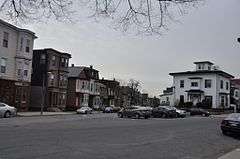Eagle Hill Historic District
|
Eagle Hill Historic District | |
|
Monmouth Square on Eagle Hill | |
   | |
| Location | East Boston, Boston, Massachusetts |
|---|---|
| Coordinates | 42°22′51.23″N 71°2′5.33″W / 42.3808972°N 71.0348139°WCoordinates: 42°22′51.23″N 71°2′5.33″W / 42.3808972°N 71.0348139°W |
| Area | 40 acres (16 ha) |
| Architectural style | Greek Revival, Italianate, Classical Revival |
| NRHP Reference # | 98000149[1] |
| Added to NRHP | February 26, 1998 |
The Eagle Hill Historic District is a residential historic district roughly bounded by Meridian, Lexington, and White Streets meeting in Prescott Square in the East Boston neighborhood of Boston, Massachusetts. This part of East Boston was developed roughly between 1834 and 1900, and includes a remarkable concentration of original housing stock. The neighborhood is dense, with a mix of single-family and multiple-family (generally two- or three-unit) wood frame housing. The preponderance of these buildings are vernacular Italianate or Renaissance Revival in style, with earlier Greek Revival and later Colonial Revival and Queen Anne styling present in smaller numbers. Some of the most prominent properties in the district are: the Donald McKay House (78-80 White St), Trinity Neighborhood House (406 Meridian St.), Paul Curtis Mansion (402 Meridian St.), William Waters Jr. House (69 Trenton St.). Another noteworthy property in the district is the East Boston High School located at the top of the hill, built on a site formerly used as a reservoir.[2]
The district was added to the National Register of Historic Places in 1998.[1]
External links
See also
References
- 1 2 National Park Service (2008-04-15). "National Register Information System". National Register of Historic Places. National Park Service.
- ↑ "NRHP nomination for Eagle Hill Historic District". Commonwealth of Massachusetts. Retrieved 2014-08-01.

